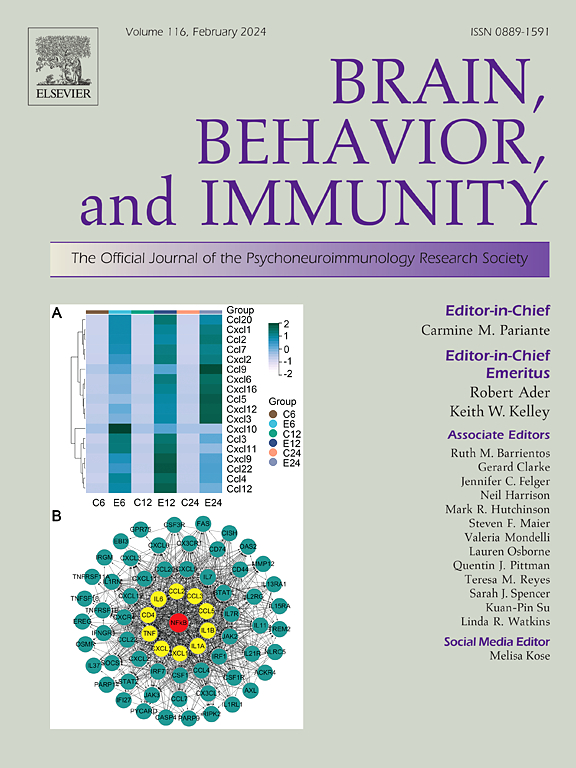Sportizumab -超过10 周的多模式进行性运动降低复发缓解型多发性硬化症患者CD8+ T细胞的Th17频率和CD49d表达:一项随机对照试验。
IF 8.8
2区 医学
Q1 IMMUNOLOGY
引用次数: 0
摘要
背景:多发性硬化症(MS)是一种神经炎性自身免疫性疾病,其特征是具有促炎特性的循环 T 细胞亚群占主导地位,中枢神经系统(CNS)归属潜能增加。大量证据证实了慢性运动干预对多发性硬化症的各种有益影响,但长期多模式剧烈运动如何影响复发性缓解型多发性硬化症患者(pwRRMS)药物通常针对的多发性硬化症相关淋巴细胞,目前尚不清楚:共有 45 名明确患有 RRMS 的参与者被随机分配到运动组(22 人)或被动等待对照组(23 人)。进行为期10周的干预,包括渐进式阻力和力量耐力锻炼(每周3次,每次60分钟)。在干预期之前(T1)和之后(T2)抽血。流式细胞术用于淋巴细胞亚群的表型分析:结果:通过平均荧光强度(MFI)量化的 CD8+ T 细胞中 CD49d 的相对蛋白表达量与残疾状况扩展量表(P = 0.007,r = 0.440)显著相关,仅在运动组中有所下降(P = 0.001),并且在 T2 时运动组显著低于对照组(P +CD20+ T 细胞频率在 T2 时显著低于对照组(P = 0.003),但未显示出显著的时间效应:结论:为期10周的多模式运动干预主要影响多发性硬化症病理生理表型的循环T细胞。CD49d MFI的降低表明致病性Th17细胞的频率降低,CD8+ T细胞的中枢神经系统归属潜能降低,这些发现证实了运动对多发性硬化症疾病活动和进展相关细胞生物标志物的积极影响。为了证实运动对这两个疾病领域的有益影响,临床终点(即复发率、病灶形成、EDSS评分)应与这些细胞和分子标记物一起在样本量更大、持续时间为六到十二个月或更长的研究中进行评估。本文章由计算机程序翻译,如有差异,请以英文原文为准。
Sportizumab – Multimodal progressive exercise over 10 weeks decreases Th17 frequency and CD49d expression on CD8+ T cells in relapsing-remitting multiple sclerosis: A randomized controlled trial
Background
Multiple Sclerosis (MS) represents a neuroinflammatory autoimmune disease characterized by the predominance of circulating T cell subsets with proinflammatory characteristics and increased central nervous system (CNS)-homing potential. Substantial evidence confirms various beneficial effects of chronic exercise interventions in MS, but it is unknown how long-term multi-modal intense exercise affects MS-associated lymphocytes that are commonly targeted by medication in persons with relapsing remitting MS (pwRRMS).
Methods
A total of 45 participants with defined RRMS were randomized to either the exercise (n = 22) or passive waitlist-control group (n = 23). A 10-week intervention consisting of progressive resistance and strength-endurance exercises was applied (3x/week à 60 min). Blood was drawn before (T1) and after (T2) the intervention period. Flow cytometry was used for phenotyping lymphocyte subsets.
Results
Relative protein expression of CD49d within CD8+ T cells, quantified via mean fluorescence intensity (MFI), is significantly associated with the Expanded Disability Status Scale (p = 0.007, r = 0.440), decreased in the exercise group (p = 0.001) only, and was significantly lower in the exercise compared to the control group at T2 (p < 0.001). T helper (Th) 17 cell frequency decreased only in the exercise group (p < 0.001). CD8+CD20+ T cell frequency was significantly lower in the exercise compared to the control group at T2 (p = 0.003), without showing significant time effects.
Conclusion
The 10-week multimodal exercise intervention mainly affected circulating T cells harboring a pathophysiological phenotype in MS. The findings of a decreased frequency of pathogenic Th17 cells and the reduced CNS-homing potential of CD8+ T cells, indicated by reduced CD49d MFI, substantiate the positive effects of exercise on cellular biomarkers involved in disease activity and progression in MS. To confirm exercise-mediated beneficial effects on both disease domains, clinical endpoints (i.e., relapse rate, lesion formation, EDSS score) should be assessed together with these cellular and molecular markers in studies with a larger sample size and a duration of six to twelve months or longer.
求助全文
通过发布文献求助,成功后即可免费获取论文全文。
去求助
来源期刊
CiteScore
29.60
自引率
2.00%
发文量
290
审稿时长
28 days
期刊介绍:
Established in 1987, Brain, Behavior, and Immunity proudly serves as the official journal of the Psychoneuroimmunology Research Society (PNIRS). This pioneering journal is dedicated to publishing peer-reviewed basic, experimental, and clinical studies that explore the intricate interactions among behavioral, neural, endocrine, and immune systems in both humans and animals.
As an international and interdisciplinary platform, Brain, Behavior, and Immunity focuses on original research spanning neuroscience, immunology, integrative physiology, behavioral biology, psychiatry, psychology, and clinical medicine. The journal is inclusive of research conducted at various levels, including molecular, cellular, social, and whole organism perspectives. With a commitment to efficiency, the journal facilitates online submission and review, ensuring timely publication of experimental results. Manuscripts typically undergo peer review and are returned to authors within 30 days of submission. It's worth noting that Brain, Behavior, and Immunity, published eight times a year, does not impose submission fees or page charges, fostering an open and accessible platform for scientific discourse.

 求助内容:
求助内容: 应助结果提醒方式:
应助结果提醒方式:


